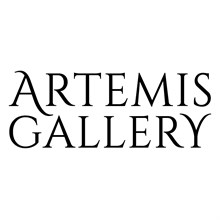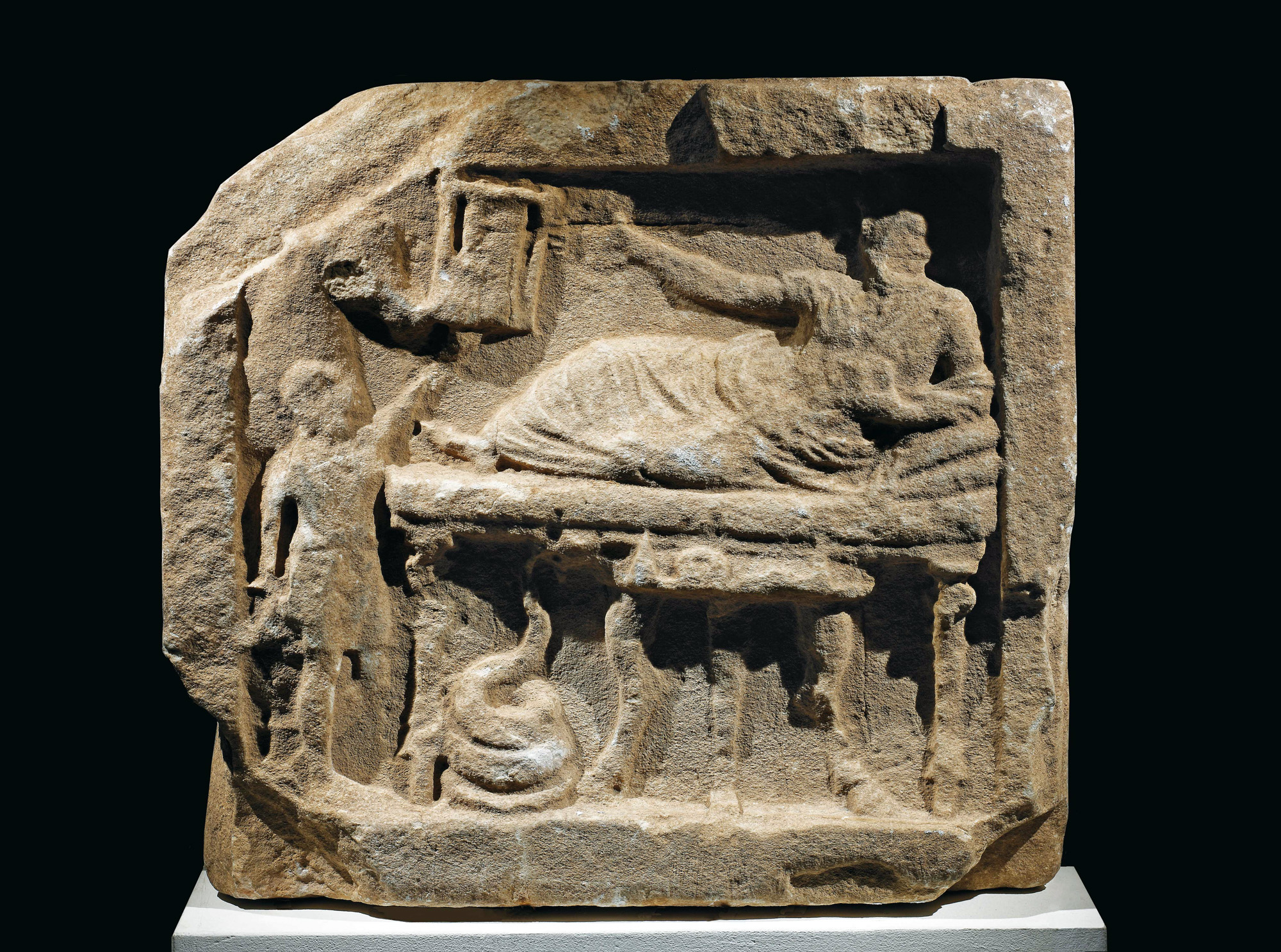38
Greek Marble Relief of Funerary Banquet Greece, ca. late 3rd to early 2nd century BCE. A cloaked man
Description
Greek Marble Relief of Funerary Banquet
Greece, ca. late 3rd to early 2nd century BCE. A cloaked man lies with his bare chest turned towards the beholder. He holds a drinking vessel in his left hand. With his right hand he gestures towards a shrine in the background. A small boyish figure also points
towards it with his left arm. The head and forequarters of a horse to the left of the shrine. A snake and a table with three legs which bears various vessels. Three corners of the broad frame are cut away. In the top left corner, part of the relief is also missing. Reverse roughly smoothened. Size: 23-7/8"H (60 cm).
For the style and the motif, also that of the horse's head, cf. U. Hausmann, Griechische Weihreliefs (Berlin 1960) 25ff., illus. 12; L. Budde-R. Nicholls, A Catalogue of Greek and Roman Sculpture in the Fitzwilliam Museum Cambridge2, Cat. Cambridge (Cambridge 1967) 37f., nos. 63-64, pl. 20. Reliefs with funerary banquets depict the deceased as a hero in a larger scale and with his chest bared. As such he is an intermediary between the human and heavenly worlds. The horse's head is an attribute of the hero. The snake is a chthonic symbol linking the scene to the underworld.
Provenance: Ex-private Herbert A. Cahn collection, Basle, 1960-1970.
All items legal to buy/sell under U.S. Statute covering cultural patrimony Code 2600, CHAPTER 14, and are guaranteed to be as described or your money back.
A Certificate of Authenticity will accompany all winning bids.
#108633
Condition
Overall good with expected wear especially on the head and right hand of the recumbant figure, head, arms and left leg of the smaller figure, frame and legs of kline and table.
Greece, ca. late 3rd to early 2nd century BCE. A cloaked man lies with his bare chest turned towards the beholder. He holds a drinking vessel in his left hand. With his right hand he gestures towards a shrine in the background. A small boyish figure also points
towards it with his left arm. The head and forequarters of a horse to the left of the shrine. A snake and a table with three legs which bears various vessels. Three corners of the broad frame are cut away. In the top left corner, part of the relief is also missing. Reverse roughly smoothened. Size: 23-7/8"H (60 cm).
For the style and the motif, also that of the horse's head, cf. U. Hausmann, Griechische Weihreliefs (Berlin 1960) 25ff., illus. 12; L. Budde-R. Nicholls, A Catalogue of Greek and Roman Sculpture in the Fitzwilliam Museum Cambridge2, Cat. Cambridge (Cambridge 1967) 37f., nos. 63-64, pl. 20. Reliefs with funerary banquets depict the deceased as a hero in a larger scale and with his chest bared. As such he is an intermediary between the human and heavenly worlds. The horse's head is an attribute of the hero. The snake is a chthonic symbol linking the scene to the underworld.
Provenance: Ex-private Herbert A. Cahn collection, Basle, 1960-1970.
All items legal to buy/sell under U.S. Statute covering cultural patrimony Code 2600, CHAPTER 14, and are guaranteed to be as described or your money back.
A Certificate of Authenticity will accompany all winning bids.
#108633
Condition
Overall good with expected wear especially on the head and right hand of the recumbant figure, head, arms and left leg of the smaller figure, frame and legs of kline and table.
Auction Details
Shipping
T&Cs & Important Info
Ask seller a question
Greek Marble Relief of Funerary Banquet
Greece, ca. late 3rd to early 2nd century BCE. A cloaked man lies with his bare chest turned towards the beholder. He holds a drinking vessel in his left hand. With his right hand he gestures towards a shrine in the background. A small boyish figure also points
towards it with his left arm. The head and forequarters of a horse to the left of the shrine. A snake and a table with three legs which bears various vessels. Three corners of the broad frame are cut away. In the top left corner, part of the relief is also missing. Reverse roughly smoothened. Size: 23-7/8"H (60 cm).
For the style and the motif, also that of the horse's head, cf. U. Hausmann, Griechische Weihreliefs (Berlin 1960) 25ff., illus. 12; L. Budde-R. Nicholls, A Catalogue of Greek and Roman Sculpture in the Fitzwilliam Museum Cambridge2, Cat. Cambridge (Cambridge 1967) 37f., nos. 63-64, pl. 20. Reliefs with funerary banquets depict the deceased as a hero in a larger scale and with his chest bared. As such he is an intermediary between the human and heavenly worlds. The horse's head is an attribute of the hero. The snake is a chthonic symbol linking the scene to the underworld.
Provenance: Ex-private Herbert A. Cahn collection, Basle, 1960-1970.
All items legal to buy/sell under U.S. Statute covering cultural patrimony Code 2600, CHAPTER 14, and are guaranteed to be as described or your money back.
A Certificate of Authenticity will accompany all winning bids.
#108633
Condition
Overall good with expected wear especially on the head and right hand of the recumbant figure, head, arms and left leg of the smaller figure, frame and legs of kline and table.
Greece, ca. late 3rd to early 2nd century BCE. A cloaked man lies with his bare chest turned towards the beholder. He holds a drinking vessel in his left hand. With his right hand he gestures towards a shrine in the background. A small boyish figure also points
towards it with his left arm. The head and forequarters of a horse to the left of the shrine. A snake and a table with three legs which bears various vessels. Three corners of the broad frame are cut away. In the top left corner, part of the relief is also missing. Reverse roughly smoothened. Size: 23-7/8"H (60 cm).
For the style and the motif, also that of the horse's head, cf. U. Hausmann, Griechische Weihreliefs (Berlin 1960) 25ff., illus. 12; L. Budde-R. Nicholls, A Catalogue of Greek and Roman Sculpture in the Fitzwilliam Museum Cambridge2, Cat. Cambridge (Cambridge 1967) 37f., nos. 63-64, pl. 20. Reliefs with funerary banquets depict the deceased as a hero in a larger scale and with his chest bared. As such he is an intermediary between the human and heavenly worlds. The horse's head is an attribute of the hero. The snake is a chthonic symbol linking the scene to the underworld.
Provenance: Ex-private Herbert A. Cahn collection, Basle, 1960-1970.
All items legal to buy/sell under U.S. Statute covering cultural patrimony Code 2600, CHAPTER 14, and are guaranteed to be as described or your money back.
A Certificate of Authenticity will accompany all winning bids.
#108633
Condition
Overall good with expected wear especially on the head and right hand of the recumbant figure, head, arms and left leg of the smaller figure, frame and legs of kline and table.
Exceptional Ancient and Ethnographic Art
Sale Date(s)
Venue Address
P.O. BOX 714
Erie
Colorado
80516
United States
For Artemis Gallery LIVE delivery information please telephone +1 7205025289.
Important Information
Join us for an important one-day auction featuring museum-worthy examples of classical antiquities, ancient and ethnographic art from cultures encompassing the globe. Included are an incredible ancient Egyptian wooden box with translated panels, a rare 12th century 22+ karat pure gold Burmese Buddha. Egyptian, Greek, Roman, Etruscan, Near Eastern, Asian, Pre-Columbian, Native American, Spanish Colonial, Russian, even a 17th century Spanish Oil Painting! Don’t miss these truly important examples unlikely to come to market again!


